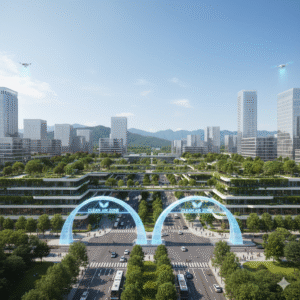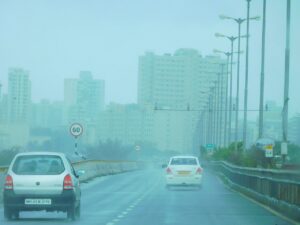While walking home from my office in Mumbai, I am often struck by the diversity of experiences along the way. The walk is a little over a kilometer and can be taken via different routes. Interestingly, the shortest route is not always the most convenient. However, it offers more experiences, and a few small challenges, which keep my “thinking hat” active. As a pedestrian navigating this 12- to 15-minute stretch on the streets of Mumbai I observe that it is influenced by considerations such as convenience, safety, and curiosity.
The 15-minute walk can primarily be taken via three different routes:
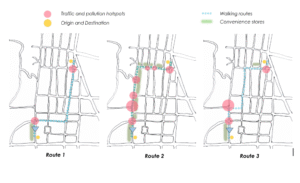
Route 1: The most convenient and preferred route is along a tree-lined street; a rare sight in Mumbai’s urban landscape. With generous green cover and large canopies, it offers flat, well-maintained pavements and minimal traffic during office hours. It’s flanked mainly by residential buildings, and the lighter traffic means better air quality; a healthier, quieter walk.
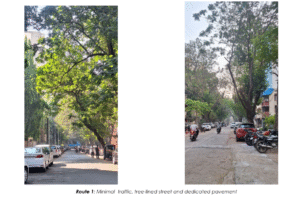
Route 1: Minimal traffic, tree-lined street and dedicated pavement
Route 2: Although Route 1 offers better air quality, most convenience stores lie along Route 2, making it the more functional choice. This stretch is part of a busy bus corridor and connects a number of neighbourhoods. Traffic peaks during office hours and weekends due to nearby restaurants, recreational spaces, and tourist hotspots. Additionally, fruit and vegetable vendors, street food carts, and small eateries stationed at key junctions contribute to traffic congestion by stalling both pedestrians and vehicles.
The absence of dedicated pavements further complicates pedestrian safety. Where pavements do exist, they are often blocked by hawkers or unattended road infrastructure materials. These factors not only make the route unsafe but also result in poor air quality. Despite its drawbacks, Route 2 is often chosen out of necessity, thanks to its access to convenience stores.
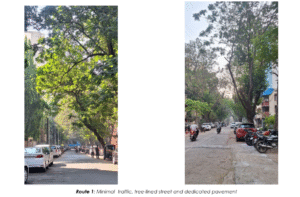
Route 2: Significant traffic, bus routes with no pavements or blocked pavements, traffic congestion resulting in air pollution
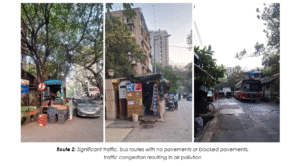
Route 3: This route is the most interesting as it begins with a tree-covered stretch and winds into a charming, historic neighbourhood of Pali Village. Once a fishing hamlet inhabited by the Kolis, Mumbai’s original coastal community, the area retains its rustic charm, and walking through it feels like a glimpse into the city’s layered past.
From a quality-of-walk perspective, Routes 1 and 3 are preferable. But practicality often nudges me toward Route 2, even though it comes with more dust, noise, and risk.
Route 3: Tree-covered stretch and an interesting route through Pali Village
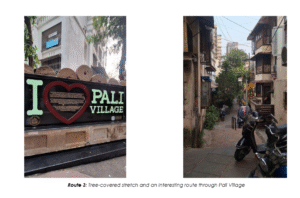
The contrast between these three routes raises important questions:
- Can we reposition hawkers and street vendors to alleviate traffic congestion caused by stalled vehicles and pedestrians?
- Can we improve pavement access and ensure regular maintenance to enhance pedestrian safety?
- Can road dust levels be controlled by addressing abandoned or ongoing roadworks?
- Can we promote better public transport options to reduce dependency on private vehicles, thereby lowering vehicular pollution?
On a lighter note, as I write this blog, none of the three routes currently seem viable. Why? Because all the roads have been dug up! That’s quintessential “Mumbai – Always Under Construction!”
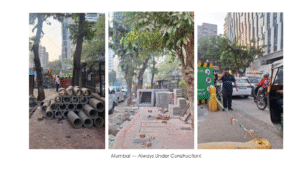
Mumbai — Always Under Construction!

